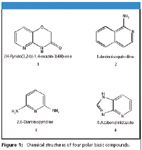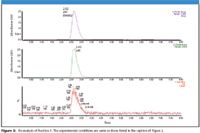A Case Study of Using Thar SFC-MS Prep 30® to Purify Polar, Basic Pharmaceutical Relevant Compounds
The Application Notebook
In the past decade, supercritical fluid chromatography (SFC) has experienced a striking resurgence and exponential growth in acceptance, particularly in pharmaceutical and chemical laboratories. In SFC, "supercritical" CO2, in combination with one or more polar organic solvents, most commonly alcohols, are used as mobile phase. The polarity of CO2 is similar to that of hexane, and thereby making SFC a normal phase chromatographic technique. SFC has readily lent itself as an attractive complement to reversed phase HPLC (RPLC). For instance, in separating polar compounds that have little retention, and/or selectivity, even with special polar group embedded columns, SFC holds a unique advantage over RPLC due to its normal phase separation mechanism.
Peter Ridgway and Rui Chen, Ph.D., Thar Instruments, Inc.
In the past decade, supercritical fluid chromatography (SFC) has experienced a striking resurgence and exponential growth in acceptance, particularly in pharmaceutical and chemical laboratories. In SFC, "supercritical" CO2, in combination with one or more polar organic solvents, most commonly alcohols, are used as mobile phase. The polarity of CO2 is similar to that of hexane, and thereby making SFC a normal phase chromatographic technique. SFC has readily lent itself as an attractive complement to reversed phase HPLC (RPLC). For instance, in separating polar compounds that have little retention, and/or selectivity, even with special polar group embedded columns, SFC holds a unique advantage over RPLC due to its normal phase separation mechanism.

Figure 1
Preparative SFC is deemed by many to hold the greatest promise to first attain main-stream acceptance. The reduction in solvent consumption and collection in relatively small volume of volatile organic solvents, hence, much less stringent post-purification endeavor, lead to significant savings on operation cost. A mass directed preparative SFC system, like its counterpart in LC, will further expedite the work flow in drug discovery owing to the specificity and universality MS detection can offer.

Figure 2
Thar SFC-MS Prep 30® system, the only fully integrated and commercially available MS directed preparative SFC system, consists of a Waters 3100 mass detector, a Waters 2757 sample managing module for open bed fraction collection, and Thar SFC front end with a total flow rate up to 30 g/min. The system is operated on the Masslynx/Fractionlynx software platform from Waters Corporation. We present herein a case study of using Thar SFC-MS Prep 30® to purify a mixture of four polar, basic pharmaceutical compounds, where RPLC failed due to the high polarities of the compounds.

Figure 3
Figure 1 shows four polar, basic pharmaceutical relevant compounds used in this study. Despite every effort to optimize the separation, attempts in separating this mixture by RPLC yielded co-eluting peaks (results not shown) due to their high polarity. Figure 2 shows the SFC chromatogram of the mixture obtained with a total injection of 10 mg onto the column. All four compounds were baseline resolved using a 2-ethyl pyridine column. A representative re-analysis of the fractions for purity determination is also shown in Figure 3. Note that these analyses were performed on the same system, and it is expected that significant errors might have accrued from this approach. Finally, a total of 10 replicate injections (25 mg for each compound) were then performed. Each compound was collected into their respective tube and subsequently dried down and weighed. The recovery and purity data are listed in Table I. Recovery ranges from 81% to 94% and purity ranges from 85% to 99%, both comparable to the typical values one would expect from a similar MS directed prep LC system. The overall experiment can be further optimized by adjusting the split ratio to minimize the tailing of MS peaks and/or reduce the sample loading.

Table I: The overall recovery and purity of the collected fractions
In this short communication, a case study of using Thar SFC-MS Prep 30® to purify a mixture of four polar, basic pharmaceutical compounds was described. Compared to RPLC, there is a dramatic improvement in retaining and separating these compounds by SFC. This application exemplifies the orthogonality of SFC to RPLC, especially for separating polar compounds. Using Thar SFC-MS Prep 30® , reasonable recovery and purity were achieved for all compounds, comparable to the typical values one can obtain using a MS-directed prep LC system.

Thar Instruments, Inc.
575 Epsilon Drive, Suite 100
Pittsburgh, PA 15238
tel. (412) 967-5665, fax 412 967-9446

SEC-MALS of Antibody Therapeutics—A Robust Method for In-Depth Sample Characterization
June 1st 2022Monoclonal antibodies (mAbs) are effective therapeutics for cancers, auto-immune diseases, viral infections, and other diseases. Recent developments in antibody therapeutics aim to add more specific binding regions (bi- and multi-specificity) to increase their effectiveness and/or to downsize the molecule to the specific binding regions (for example, scFv or Fab fragment) to achieve better penetration of the tissue. As the molecule gets more complex, the possible high and low molecular weight (H/LMW) impurities become more complex, too. In order to accurately analyze the various species, more advanced detection than ultraviolet (UV) is required to characterize a mAb sample.

.png&w=3840&q=75)

.png&w=3840&q=75)



.png&w=3840&q=75)



.png&w=3840&q=75)














